Every day IFI hears stories of stain removal mishaps from members that could have been avoided with better training and understanding. Here are 10 common stain removal pitfalls and how to avoid them.
1. Failure to Test for Colorfastness
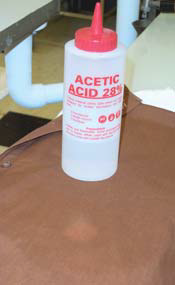
Always, always test for colorfastness before using a stain removal agent—it’s a simple but necessary step that can help avoid a lot of headaches. Failure to do so can result in color loss or a color change.
Some dyes are affected by acids such as tannin formulas, acetic acid, rust remover, and general formulas, while others are affected by strong alkalis such as protein formulas and ammonia. Volatile dry solvent, oily type paint remover, and amyl acetate can damage pigment-printed fabrics.
2. Inappropriate Use of Sodium Perborate

The alkaline-oxidizing bleach sodium perborate is often referred to as an all-fabric bleach. This is not the case! It can yellow white wool and silk and is not safe on some colors.
3. Improper Use of Chlorine
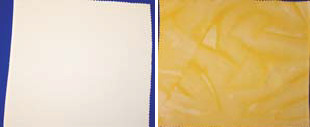
Chlorine bleach (sodium hypochlorite) is an alkaline-oxidizing bleach. It is unsafe for use on fabrics containing silk, wool, spandex, or nylon fibers. Chlorine bleach can also remove the color from many fabrics. Test for colorfastness before doing any stain removal with chlorine bleach.
4. Rushing Digesters
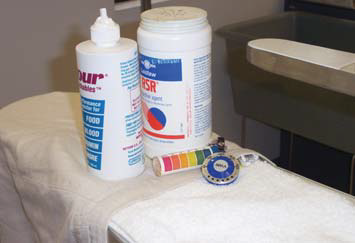
To remove the last traces of stubborn milk, egg, blood, or other protein stains, use a digester. But digesters need time to work their magic, so don’t rush. First, flush the area thoroughly with steam and apply the digester. Keep the area warm and wet for 15 minutes or longer—this is necessary in order for the digester to work. After 15 minutes, you may have to reapply the digester to remove the stain. After digesting, flush the area thoroughly with steam or water.
5. Digging with a Spatula
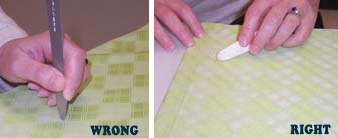
The purpose of the spatula is to gently work stain removal agents over the stain and into the fabric. This action helps to break up the stain so it can be flushed from the fabric. What you’ll usually see instead is the technician attempting to “dig” the stain out with the pointed edge of the spatula. This improper use of the spatula is a sure way to cause fabric damage.
The proper technique is to use the rounded surface of the spatula, allowing it to come in contact with the stains about half an inch from the point. Very little pressure should be applied.
6. Incorrect Spotting Procedures
Using the wrong procedure is easily one of the most common reasons for unsuccessful stain removal. The majority of stains can be put into seven or eight different categories. Each category has a specific method for applying stain removal agents. One false move and you can set the stain. Without proper knowledge, you are setting yourself up for certain failure.
Most companies that supply stain removal chemicals have stain removal guides to help put spotters on the right track. But the best possible training on stain removal comes from formal training in the classroom. Investing in how to do it right can only improve your quality and decrease your claims.
7. Not Enough Patience
It seems everyone wants to hear the big secrets to stain removal. Well, here’s one: Slow down! It’s not unusual to see someone apply a stain removal chemical to a stain, whack it a few times with a brush, and flush the product out almost immediately. You must allow enough time for the stain removal agents to dissolve the stain and enough mechanical action from the brushes or spatula to break it up. Stains like nail polish and whiteout may require several applications of the agents before they start to break down.
8. Little or No Knowledge of Basic Chemistry
There’s a reason why tannin formulas work on coffee stains and why protein formulas work on blood. It’s the science of stain removal. Some stain removal agents carry a pH. If you apply the correct pH to a stain, you may be able to successfully remove it. If you apply the wrong pH, you may set the stain in permanently.
You can’t use all stain removal chemicals on every type of fabric. Alkaline pH stain removal chemicals, such as protein formulas, can turn white silk and wool fabrics to yellow. Using dry-side solvents on wet-side stains is a big waste of time. Not knowing the science usually results in decreased stain removal and increased expenses.
9. Unnecessarily Spreading Stains
Tamping or using the bone spatula too soon can cause a stain to spread and become more difficult to remove. To prevent a stain such as paint, nail polish, or whiteout from spreading, apply the appropriate stain removal agent and gently blot using the corner of a towel.
10. Rubbing While Wet
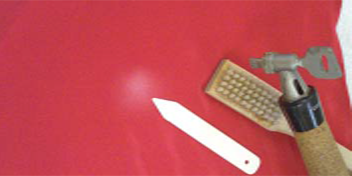
A white, chalky appearance called chafing occurs when a fabric is rubbed or brushed aggressively while the fabric is wet. Heavy tamping with a brush, holding the brush improperly, or improperly using the spatula can cause chafing.
When holding the brush, keep it perpendicular to the fabric at a 90° angle. Don’t use the spatula to rub the stain out of a fabric. Minimize the amount of pressure applied to the fabric. Excessive rubbing or pressure will result in chafing. Additionally and probably the most common cause of chafing: dry cleaning an item without thoroughly drying it after using agents containing water.
This article is from IFI’s TOI708

